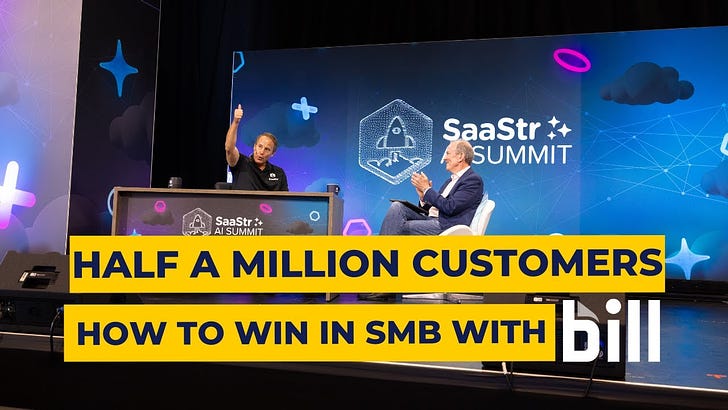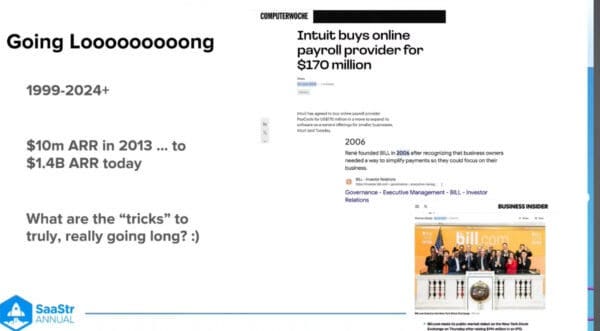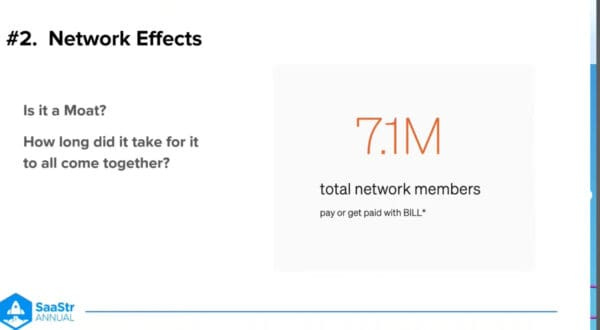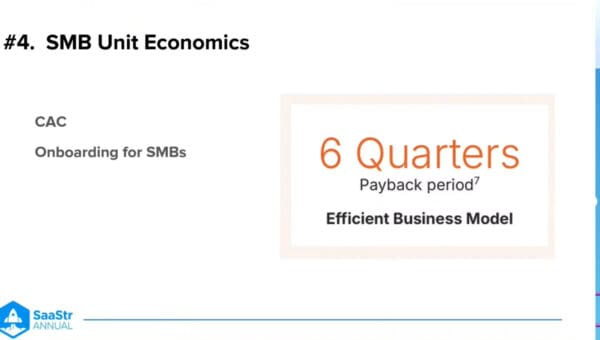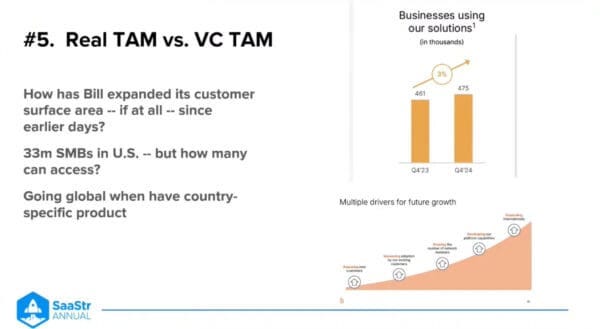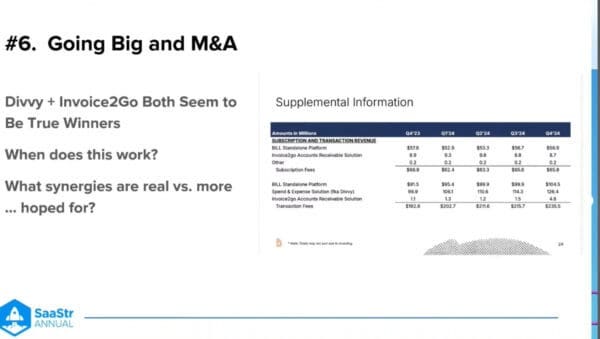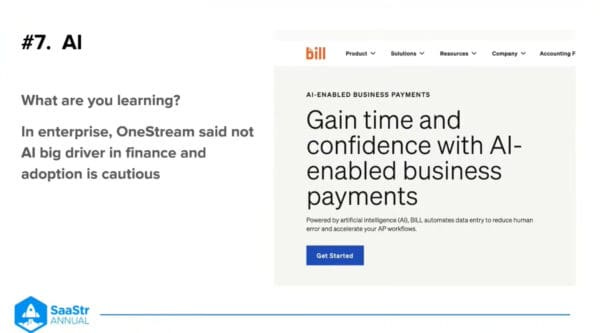How to Win with SMBs with BILL CEO and Founder René Lacerte
"When BILL went to their first customers, who were friends, they said, “I don’t need this. I already have a solution.”
BILL CEO and Founder René Lacerte set out to define a category around financial operations for small and midsize businesses (SMBs) way back in 2016. Needless to say, he succeeded. At SaaStr’s AI Summit during the SaaStr Annual, René chatted with SaaStr CEO and founder Jason Lemkin about how BILL has reached half a million customers and $1.3B in ARR.
Are We In a Downturn?
Jason starts with the meta-question we’ve been asking a lot of SaaS leaders lately (Klaviyo, ZoomInfo) — ‘are we in a downturn?’
Bill is approaching half a million customers, so has a good pulse on small businesses. René answers, “What we’ve seen this year is more stabilization in the last three quarters. So I call this the wait-and-see economy.”
Investing for growth has been pretty flat year over year for SMBs, which means there is money there, but they’re holding onto it.
For SMBs, BILL provides a huge value at a low cost compared to that value. When you’re “cheap,” you’re more immune to some of these effects. This is true for BILL. Their focus has been on creating value for customers, which creates word of mouth.
Selling to Multiple Stakeholders
If you sell into the Enterprise, you understand there are different stakeholders. With SMBs, the smallest business is owner-operated. A mobile phone is their dominant source of managing business activities.
When you get bigger, say 20 to 50 to 100 monthly transactions, you probably have an accounting person in BILL daily. Then, you get to the people who need to approve a transaction. The mobile phone user has the highest NPS as a BILL user because it’s super simple and easy, and the clerk does all the data entry, pulling everything in and managing it. So, you have to pay attention to each of these stakeholders.
This gets more challenging when you have stakeholders who aren’t the ones buying the software. So at BILL’s scale, you have to put programs into place across the company to connect employees to customers, to help you focus on all the different stakeholders vs just the contract signer.
“It does start at the top,” René explained. “I will go into any roadmap discussion and I will be talking about the product. I’m in the UX Slack channel reporting bugs and that helps people know that, ‘Hey, this is valued in the culture’ and that we all need to use the application and understand the customer experience.
Going Long
We’ve written before on the power of going long in SaaS. How do you do it in practicality?
René has several tips and tricks for going long since he’s been at it for around 32 years, so he knows what he’s talking about.
You have to know your why. Why are you doing what you’re doing? Whether you have ten employees or 2200, the why stays the same.
There are multiple ways to set goals. Some people like SMART goals (specific, measurable, achievable, relevant, and time-bound). René, not so much. He likes HARD goals (heartfelt, animated, required, and difficult).
Those two things become motivations. The other part is balancing your work with taking care of yourself. Like they say, you can’t put a mask on your child first, even if your instincts tell you to do so. You have to look after yourself, or you won’t be useful to anyone. Do what gives you energy. Listen to music, exercise, and eat well. That’s how you go long.
When It Takes 5 Years To Reach A Vision
When BILL went to their first customers, who were friends, they said, “I don’t need this. I already have a solution.” Because they were friends, René asked them to try it anyway and 90 days later, they were amazed.
You have to keep going when you’re doing something that wasn’t done before. There was an inflection point for BILL around 10k customers. The network was growing, and they saw real virality. That was probably 2012.
Then, in 2017, with around $50M in revenue, BILL added payment capabilities. That was always the plan when BILL went public in 2019. BILL network has 7.1M network members who have used BILL to pay or get paid. Let’s look at what kind of moat it is.
Creating a Moat
”I definitely believe it’s a moat, and it’s the thing that got me most excited about the business,” René shares. Before BILL, around 2004, he started thinking more about this problem of doing finances with filing cabinets and a lot of pain, the same way it was done 60 years prior.
He had the idea that the Cloud, not called the Cloud back then, would enable two entities to see the same transaction from their perspective. The thing with a moat is that it takes time. Businesses take time to adopt, unlike consumers who joined TikTok by the tens of millions.
You have to be thoughtful about moving people’s money. If you screw up one payment, customers are going to be angry. Be prepared for that if you move peoples’ money as a business.
1% of GDP goes through BILL. A trillion dollars has gone through BILL in the last five years, so you have to do it safely, securely, efficiently, and fast.
Creating Stickiness
BILL connects your documents, employees, suppliers, and every part of the transaction.
The entirety of your company’s history of bill transactions is hard to build up again. That’s the sticky part. On the network side, every supplier in your network is there, complete with their bank info. That’s the part that becomes a moat competitively. BILL is moving money and doing it well, all while being highly regulated.
Bill Has Acheived 80% Gross Margins — How?
If we step back to 2004-2005, when BILL was just an idea, the first realization was that this had to be simple. SMBs couldn’t do any work to add their bank accounts, and they had to trust BILL to take their money. On day one, they used Microsoft Money to print checks for early customers. There was no software yet.
It was on the customer’s account. Next, it was on BILL’s account that they would send checks out. Once the money came to them, they knew this would be regulated, and getting money transmitter licenses across all 50 states would be a 5-year effort.
They went as fast as possible, but states didn’t move. When you think of the payment piece, BILL is unique because they centralize the money. How do you build trust with your customers and protect the funds? That’s the hard part.
BILL knows how to manage money and risk, and they made that happen in the platform, which creates that moat.
With a trillion in payment volume coming through BILL in the last five years, managing the payment and compliance engine has required an ongoing effort of a sizable team. Still, it’s a fundamental part of the platform that allows the rest to do what it’s supposed to do.
SMB Unit Economics: Why Is 6 Quarters the Right Target for SMBs at Scale?
If we go back to 2006, BILL was a cloud-based company. At the time, there were dozens of cloud-based companies. Today, there are thousands. That tells consumers there is too much choice.
So, SMBs are asking for consolidation, and that’s why Bill has acquired companies and continues to add more financial operation capabilities. BILL wants to be at the heart of every SMB business.
When René’s dad had a payroll company, the rule of thumb was always one year’s worth of revenue, four quarters, because a customer lasted a year. Bill does six quarters because customers stay on the platform for more than a year.
From day one, they considered having a viable business model, so they didn’t wait to build it. BILL is efficient, and LTV continues to grow, so some might say six quarters is too light because of all the value added. People tend to stay for a long time.
Six quarters seems to be the right balance, and managing P&L is always about balance. At BILL, logo retention is 86% in the first 90 days. If someone uses it, they’re golden, and it’s better than 86%.
The first 90 days have higher attrition rates because the user has yet to adopt. Once they do, it becomes stickier.
Real TAM vs. VC Tam: How Do You Think About it at Scale?
At scale, BILL’s TAM expands because of its ability to add more products and services into financial operations. TAM is customers and products, so if you can grow both, that’s great.
Their core customer TAM is 6M businesses with employees. They grew it internationally to 35M but can continue adding TAM by adding payment products.
BILL’s network members are also suppliers. About a third of core BILL revenue comes from suppliers making a choice about a payment, so BILL builds experiences for them. Have they allocated 30% of the team to focus on that? Not yet, so that’s one way to expand the TAM.
Anyone who is connected to your network or product can become a full customer, so you should go after your original TAM and expand it for more opportunities.
How to Make an Acquired Second Act Work
In 2021, BILL completed its acquisition of Divvy, a Leader in Spend Management for SMBs.
One advantage at BILL is all the bills inside of BILL. You can see companies pop up and see who customers are paying. Most were using Divvy, so they talked to those customers and learned it was the best solution. This made it an easy yet weighted decision, considering it was a $2.5B acquisition.
René wanted everything to fit together like a glove, but it was a big acquisition, with over 7,500 customers joining. It worked because it fit within financial operations, and they led with software, workflow, and budgeting, which matter for BILL customers.
AI Learnings
“Fundamental technologies become fundamental, not because of hype,” René says. This fundamental technology will be even more integrated into all of BILL’s platforms, customer service touchpoints, and engineering. It won’t just be an AI chatbot because that’s not what makes BILL successful.
What makes Bill successful is leveraging AI across the risk engine, hundreds of millions of transactions, and billions of dollars that go through Bill every year. How do you get money moving faster, sooner, and as safe as possible for customers? BILL makes 5M predictions daily using AI on all documents coming in.
Customers aren’t necessarily asking for AI, either. They’re asking for moving money faster, creating a specific workflow, and insights and forecasting so they can be strategic about what they’re spending.
Customers have a pain point, and a company’s job is to solve it. They don’t care as much about the technology as long as it’s safe and secure.

